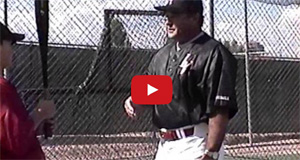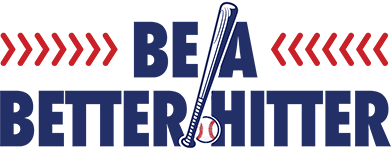The Pre-Stride

The drill that we’re talking about here is what we’re gonna put Brian in, the Pre-Stride Position, to eliminate some of the problems of swinging the bat. First thing we do with Brian is we find out what Brian’s power base is. Okay. With his power base what we’ll do is ask him to get in to the position where he feels comfortable. And what we’re gonna do is make sure that Brian is not outside the length of the bat or the lever that he’s using. So as Brian stands up here next to the plate we’re gonna set the bat down. Okay. We’re gonna make sure that Brian does not get beyond the length of the bat that he’s using in this pre-stride position.
So I’m gonna ask Brian to go ahead and take his stride that he normally takes. Go ahead Brian. Step out and take your stride. Okay now, he’s within the length of the bat that he is using so we call this the power base. Okay, when we pre-stride we wanna get Brian into that power base because that gives him the maximum leverage when he swings this bat. So we’ll keep Brian there in what we call the power base, and ask Brian to pick up his bat. Now everything that we do from this point on with this drill, in the pre-stride drill, is based off of his power base. Now the reason that we pre-stride is because now we can eliminate the lower half pretty much and work on the upper half, uh, from the hips up to the head. By pre-striding, what we’ve eliminated Brian from doing is moving his head forward when he swings, which transfers the weight. We also keep his head from moving in a vertical position, up and down, and still allows him to hit.
The only reason we take a stride, Brian, is to get rhythm and timing. so if we can eliminate the timing mechanism and still be able to get rhythm from the pre-stride drill then we’ll have more success at swinging the bat and we’ll be more consistent.
Okay. So rhythm is still important in hitting so from the pre-stride position I can get Brian to get some rhythm by taking the weight back, letting the front heel come up, okay. As the front heel comes up it’ll push him back in to what’s called a load position, letting him work from the back side here in a strong position. This is the same as taking the stride. Okay, but we haven’t left that power position so the front heel comes up to push him back. Now the front heel goes down and the back heel comes up. Okay. So in that position there, we’ve eliminated the stride so it’ll allow him to have a shorter period of the rhythm to allow him to have better timing. So now we’ve shorted that period of timing up. So he can be more consistent. So in the pre-stride position he pushes the weight back here, from heel goes down, back heel comes up.
The only reason you stride is for rhythm and timing. It does not give you power, it does not give you bat quickness or bat velocity, but just rhythm and timing.
Then our weight is going forward and that’s not what we want because when the weight goes forward the head also goes forward and we’re not seeing the ball as well from that position. Okay. To demonstrate this we can use the soft toss, or we can center toss in front behind the screen, or we can do tee. Okay, that’s the advantage of this drill. You can also do it in live BP, you can do it in game competition. Uh, particularly if a young man is struggling with the lower half you can just isolate the upper half with this drill. So we set a ball on the tee, he’ll stay in his power base which is when the length of that bat that he’s using to create the best leverage. Okay, when he’s ready to hit, he sets up he’ll push himself back, let the front heel come up, and as he starts to swing towards the ball, the front heel goes down, the back heel comes up and he gets the backside turn. Okay. Brian go ahead. We’ve asked Brian to do this and didn’t give him any chance to warm up here. Now if you watch Brian’s swing, the head stays still, stays behind the swing, and he’s down to the ball without the stride.
In the drill if you feel like you’re not in a real strong position, you can widen him out a little bit on the stance as long as he stays within the length of the lever that he’s using, or the bat. You see the head down and behind the swing because he isn’t taking the stride.
What we’ve done here at www.beabetterhitter.com is eliminate the stride which causes a lot of problems with young hitters. So in eliminating the stride, we can go to a pre-stride position, it helps us in any of the drills that we do in swinging a bat, and also helps us in a game situation. I hope this drill helps you become a better hitter.

Is the coach in the video a writer for the website? The only thing I like out of the video is the statement “the stride is for rhythm and timing.” The other stuff is silly. The “power phase” is a okay name I guess, but you frame the power phase to seem like it must be within the length of the bat that the kid uses. It’s not correct and it isn’t a rule that hitters should focus on; it’s a corrolary that happens to be true when other parts of the swing are working properly for some hitters. It just depends on the hitter. Hitters like Kris Bryant and Dustin Pedroia don’t follow your corollary, so I won’t teach that at all. Best takeaway from this video: “the stride is for rhythm and timing”